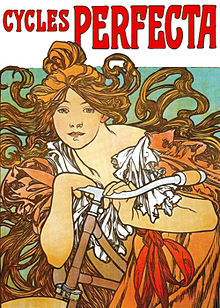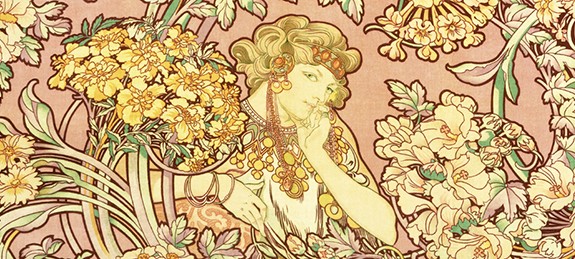Image Source: National Gallery of Art | Devianrart | Wikipedia
Art Nouveau is an international style of art, architecture and applied art—especially the decorative arts—that was most popular during 1890–1910. English uses the French name Art nouveau (“new art”), but the style has many different names in other countries. A reaction to academic art of the 19th century, it was inspired by natural forms and structures, not only in flowers and plants, but also in curved lines. Architects tried to harmonize with the natural environment.
Art Nouveau is considered a “total” art style, embracing architecture, graphic art, interior design, and most of the decorative arts including jewellery, furniture, textiles, household silver and other utensils and lighting, as well as the fine arts. According to the philosophy of the style, art should be a way of life. For many well-off Europeans, it was possible to live in an art nouveau-inspired house with art nouveau furniture, silverware, fabrics, ceramics including tableware, jewellery, cigarette cases, etc. Artists desired to combine the fine arts and applied arts, even for utilitarian objects.
Art Nouveau was in many ways a response to the Industrial Revolution. Some artists welcomed technological progress and embraced the aesthetic possibilities of new materials. Others deplored the shoddiness of mass-produced machine-made goods and aimed to elevate the decorative arts to the level of fine art by applying the highest standards of craftsmanship and design to everyday objects. Although Art Nouveau was replaced by 20th-century Modernist styles, it is now considered as an important transition between the eclectic historic revival styles of the 19th-century and Modernism.
Relationship with contemporary styles and movements
As an art style, Art Nouveau has affinities with the Pre-Raphaelites and the Symbolist styles, and artists like Aubrey Beardsley, Alphonse Mucha, Edward Burne-Jones, Gustav Klimt and Jan Toorop could be classed in more than one of these styles. Unlike Symbolist painting, however, Art Nouveau has a distinctive appearance; and, unlike the artisan-oriented Arts and Crafts Movement, Art Nouveau artists readily used new materials, machined surfaces, and abstraction in the service of pure design.
Two-dimensional Art Nouveau pieces were painted, drawn, and printed in popular forms such as advertisements, posters, labels, magazines, and the like. Japanese wood-block prints, with their curved lines, patterned surfaces, contrasting voids, and flatness of visual plane, also inspired Art Nouveau. Some line and curve patterns became graphic clichés that were later found in works of artists from many parts of the world.

Alphonse Mucha (Alfons Mucha), was a Czech Art Nouveau painter and decorative artist, known best for his distinct style. He produced many paintings, illustrations, advertisements, postcards, and designs. Mucha spent many years working on what he considered his life’s fine art masterpiece, The Slav Epic (Slovanská epopej), a series of twenty huge paintings depicting the history of the Czech and the Slavic people in general, bestowed to the city of Prague in 1928. He had wanted to complete a series such as this, a celebration of Slavic history, since he was young. From 1963 until 2012 the series was on display in the chateau in Moravský Krumlov the South Moravian Region in the Czech Republic. Since 2012 the series has been on display at the National Gallery’s Veletržní Palace. Mucha’s work has continued to inspire modern illustrators, designers, and artists.



















